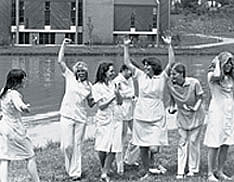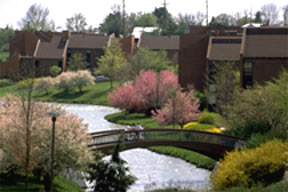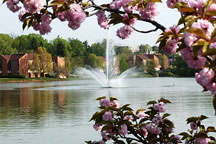 |
|---|
| The size of Newman Lake was slightly reduced by the 1990 construction of Sonner Hall. |
If there's a Kodak Moment location on the James Madison University campus, it would have to be stately Wilson Hall overlooking a perfectly-manicured and lush green Quadrangle.
But, in the picturesque competition, Newman Lake is a strong second.
Newman Lake doesn't have the longevity of Wilson Hall (1967 vs. 1931 for Wilson Hall) but it has served admirably for almost 40 years as the stunning first impression for visitors as they drive onto JMU's beautiful campus.
The lake was formed shortly after President G. Tyler Miller began expanding the Madison College campus into the area that lay adjacent to Interstate 81 and was then known as “Back Campus.” Sieberts Creek, a small stream that enters campus near the Paul Street entrance, was dammed to form the lake.
 |
|---|
| Nursing students at JMU have made a graduation weekend dip in Newman Lake an annual tradition since 1982. |
Since then, Newman Lake has been an integral part of JMU for thousands of students in the past 35 years – holding a special place in the hearts of nursing graduates, sunbathers and ducks.
Beginning in 1982, nursing students took “go jump in the lake” literally and made it a graduation tradition. Since the lake was formed, it has held a special attraction to ducks who congregate on and around the lake, sometimes in the hundreds, often bringing traffic to a screeching halt on Bluestone Drive as Mama Duck and five or six ducklings waddle single-file across the street.
Although construction around the lake has decreased “beachfront” property somewhat, sunbathers on “Newman Beach” have brought tractor-trailer traffic on nearby Interstate 81 to a crawl for years during warm weather as truckers try to catch a glimpse.
 |
|---|
| A beautiful footbridge crosses the lake near its northern end. The Lake Cluster residence halls (formerly Greek Row) are in the background. |
Picnicking near the lake has always been popular as has summertime fishing (allowed only with state and local fishing licenses). In the lake's early years, ice skating – now prohibited – was occasionally allowed when temperatures would drop to extreme lows. Swimming and boating are also prohibited.
Unfortunately, Newman Lake has had its dark moments, too. A student drowned there in the late 60s. The lake was drained in 1998 in an unsuccessful search for a missing Harrisonburg woman, who was presumed drowned. Her body was later found in a stream about a half mile from the lake. In the late 1970s, the lake was closed to fishing when a trace of mercury was found in the lake. Although mercury levels were still within federal safety limits, the lake was closed to fishing for several years as a precaution.
When it was formed, Newman Lake contained about 11 acres. Its size was reduced with the construction of Greek Row and again when Sonner Hall was built. Today, the lake covers 9.7 acres.
In the 1970s, the lake was plagued with an abundance of algae which frequently turned its surface into a yucky-looking mess. The lake was drained to try and eliminate the algae with no success. The introduction of algae-eating koi into the waters didn't help either.
 |
|---|
|
Spring blooms frame the Newman Lake fountain.
|
Finally the algae problem was solved by simply dredging the lake. Its original depth of three to four feet was increased to around six feet. The algae went away.
The final touch to Newman Lake – and the crowning point of its beauty – came in 1996 when a fountain was constructed in the center of the lake. It was given to JMU by the Estes Foundation and Martha Estes Grover ('83) in honor of her mother, Dorothy Thomasson Estes ('45).
Day in and day out, Estes Memorial Fountain sprays water high into the air, completing the Newman Lake Kodak Moment.
-- Fred Hilton
